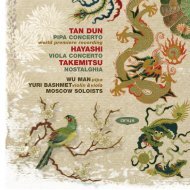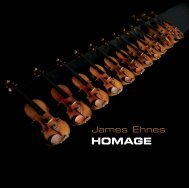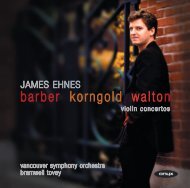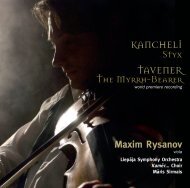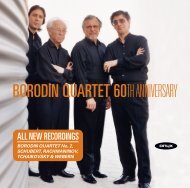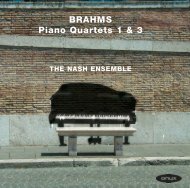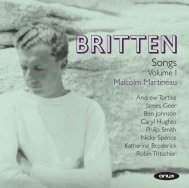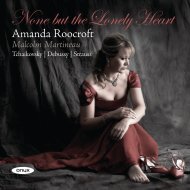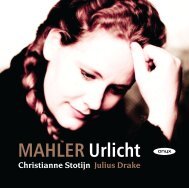BRAHMS VIOLA - Onyx Classics
BRAHMS VIOLA - Onyx Classics
BRAHMS VIOLA - Onyx Classics
- Keine Tags gefunden...
Erfolgreiche ePaper selbst erstellen
Machen Sie aus Ihren PDF Publikationen ein blätterbares Flipbook mit unserer einzigartigen Google optimierten e-Paper Software.
<strong>BRAHMS</strong> <strong>VIOLA</strong>MAXIM RYSANOV
JOHANNES <strong>BRAHMS</strong> (1833–1897)CD1 [77.35]Sonata in F minor for clarinet/viola and piano, op. 120 no. 11 I Allegro appassionato [7.52]2 II Andante un poco adagio [5.35]3 III Allegretto grazioso [4.09]4 IV Vivace [4.59]Violin Sonata no. 1 in G major, op. 78 (arr. viola Klengel/Rysanov)5 I Vivace ma non troppo [10.33]6 II Adagio [7.56]7 III Allegro molto moderato [8.05]Trio in E flat major for horn/viola, violin and piano, op. 408 I Andante – Poco piu animato [7.56]9 II Scherzo: Allegro [6.59]10 III Adagio mesto [7.18]11 IV Finale: Allegro con brio [6.03]CD2 [47.09]Sonata in E flat major for clarinet/viola and piano, op. 120 no. 21 I Allegro amabile [8.54]2 II Allegro appassionato [5.00]3 III Andante con moto – Allegro non troppo [7.41]
Trio in A minor for clarinet/viola, cello and piano, op.1144 I Allegro [7.59]5 II Adagio [8.36]6 III Andantino grazioso [4.14]7 IV Allegro [4.40]Maxim Rysanov violaKatya Apekisheva piano (CD1)Boris Brovtsyn violin (CD1, 8–11)Jacob Katsnelson piano (CD2)Kristine Blaumane cello (CD2, 4–7)Brahms and the violaThroughout his career Johannes Brahms wrote music that features the viola prominently. Among hisfirst published pieces of chamber music, the Sextets for strings, op. 18 and op. 36, contain what oftenamounts to solo parts for both violas. There are two songs for alto with viola and piano op. 91, writtenfor Joachim and his wife, and in 1884 Brahms published a viola substitute for the horn in his Trio op. 40to replace an earlier cello part that he found unsatisfactory.However it was the friendship that he struck up late in life with the clarinettist Richard Mühlfeld thatindirectly gave rise to his finest works for viola. By 1890 Brahms had seemingly tired of composingaltogether, but his warm relationship with Hans von Bülow’s famous Meiningen orchestra broughthim into contact with its principal clarinettist’s mellow and delicate playing. Thus, in the summer of1891, the re-energised Brahms began composing the first of two pairs of glorious masterpieces: theClarinet Trio op. 114 and the Clarinet Quintet op. 115, followed three years later by the two clarinetsonatas op. 120.
On publication Brahms provided alternative viola parts for all four works, and for the sonatas,violin parts as well. This was common practice, usually to help ensure the works got the widestpossible circulation. Joachim’s opinion that they would transcribe perfectly for the viola and thecare that Brahms lavished on them surely indicates more than just the commercial exigencies of hispublisher Simrock. Of the four, the Quintet predictably comes off worst, with the “solo viola” alltoo often buried within the string quartet. But in the case of the sonatas, the viola versions havebecome standard works (while those for violin remain virtually unplayed). Here, Brahms’arrangements are far more extensive in scope than in the Trio, where the viola part is mostly astraight transcription of the clarinet part. New figuration, double-stopping and even places wherethe viola extends a melody where the clarinet rests show that Brahms was concerned to give bothsonatas a new, more intimate character.Brahms seems to have felt that not every problem had been overcome: in one letter he refers to histranscriptions as “awkward and clumsy” and in another Brahms implores Mühlfeld to join him foran upcoming performance. “Otherwise,” Brahms wrote, the humour perhaps unintentional, “I shallbe forced to ask a violist.”Horn Trio, op. 40One summer morning in 1865, Brahms strolled in the Black Forest and conceived the openingtheme of the Horn Trio. He would later take the same walk with his friend Albert Dietrich: “As Icame to this spot the sun shone out and the subject immediately suggested itself.”Brahms’ mother had died the previous year, and, as with the German Requiem written at the sametime, her presence seems to inhabit the work, especially in the exceptionally brooding E flat minorslow movement marked “mesto” (“sorrowful”). The work is exceptional in that not one of themovements is in sonata form, but there is a wealth of high-quality thematic material and manymotivic links between the movements. The finale (almost inevitably) is a hunting scene and theonly cheerful part of an otherwise contemplative work.Violin Sonata no. 1 in G major, op. 78The G major sonata of 1879 is the first of three composed for Joseph Joachim when he and Brahmswere refining the solo part of the recently premiered Violin Concerto. The sonata is a smaller-scale
companion piece, gently unfolding from a repeated three-note dotted rhythm. In the finale it istransformed into the opening of the Brahms song which gives the sonata its nickname: the Regenlied(Rain Song), op. 59. In it the pattering rain evokes a yearning for childhood innocence. The sonata as awhole has been described as “an idyll under cloudy skies”, and for Clara Schumann the last movementshould “accompany me in my journey from here to the next world”.The arrangement for viola recorded here is the only one not made by Brahms. Paul Klengel (1854–1935)was a “house arranger” for Simrock, Brahms’ publisher. His name was left off the first printing and itwas later republished, erroneously, as arranged by Brahms. For this recording Maxim Rysanov hasmade various minor amendments.Trio, op. 114The Clarinet Trio and Quintet were both premiered by Mühlfeld on the same day, and although thelatter has become the more popular of the two, it was the more concise and understated Trio thatBrahms preferred. A persistent air of sadness pervades the first movement, also notable for archaiceffects such as the inverted canon of the first movement’s second theme in the manner of Haydn, acomposer whom Brahms revered.In the slow movement especially the clarinet is set in tender rivalry with the cello, drawing fromBrahms’ friend Eusebius Mandyczewski the comment: “It is as if the instruments are in love with eachother.” The Andantino that follows replaces the normal full-blooded scherzo, though it follows itsstructure with lilting outer sections framing a central Ländler. The most forceful moments arereserved for the finale – where the lyricism is tinged with an unease heightened by the alternation ofduple and triple time – and the coda ends without hope in the minor key.Sonatas, op. 120Brahms wrote the op. 120 Sonatas in summer 1894, just months after the deaths of his great friendsHans von Bülow and Theodor Billroth. An inevitable air of resignation pervades both works, withtempos and dynamics increasingly restrained. In many ways they are backward-looking, as nostalgicand resigned as their ageing and increasingly lonely composer, but while there is nothing new in themstructurally or harmonically, their “powerful synthesis of significant moments in the master’s art”(Karl Geiringer) and a tender, autumnal melancholy has ensured them a favoured place inthe repertory.
The first sonata has the normal four-movement order and is the larger-scale and more outwardlyemotional of the two. The key, F minor, had been a turbulent one for Brahms in his youthful PianoQuintet and something of that dark turbulence pervades the opening movement, rich in interrelatedthemes. It ends in the tonic major and unusually all three remaining movements are also in the major,reflecting a journey from relative darkness to light.The dreamy and song-like Andante is one of Brahms’ most exquisite slow movements: texturallyaustere at the outset but gradually revealing a glowing inner warmth. The triple-time Allegro grazioso,also in A flat major, begins as an easy-going waltz, though it is derived from the stormy first movementand the more sombre middle section sees the final appearance of F minor in the work. The Vivacefinale is a rondo in F major, its main motif the bell-like tolling of three repeated notes, presentthroughout except in the minor-key central section. The final appearance of the theme is delayed bythe repetition of the first episode, and the sonata ends with ever greater interplay betweenthe instruments.The second sonata is more restrained and intimate. Containing only three movements, it is a fantasialikeconception where extremes of tempo are avoided. Tranquil and lyrical are the words that cometo mind in the first movement. Its unusual tempo marking, Allegro amabile, is one that Brahms hadused previously in the A major violin sonata, “amabile” best translated as “amiably”or “pleasantly”.The second movement is an animated scherzo (Brahms’ last) in E flat minor that pivots enharmonicallyE flat/D sharp to B major for a sombre, almost religious sostenuto central section. The folk song-liketheme returns unaltered, outlining a perfect ternary form and echoing the form of the late pianoIntermezzi. The final movement is a theme (which in itself recalls Beethoven’s Andante favori) andfive variations of great rhythmic interest, where only in the last minor-key variation is some of theusual virtuosity of the form forthcoming. Calm returns briefly before a powerful coda, based on thetheme’s last four notes, signs off Brahms’ last contribution to a lifetime’s immersion in chamber music.ONYX 2008
Brahms und die BratscheJohannes Brahms hat während seiner gesamten Laufbahn Werke geschrieben, in denen der Bratscheeine prominente Rolle zukommt. Unter den ersten veröffentlichten Kammermusiken finden sichbeispielsweise die beiden Streichsextette op. 18 und op. 36, in denen die Bratschen immer wiederquasi solistische Momente haben. Ferner entstanden für Joseph Joachim und dessen Ehefrau die zweiLieder für Altstimme, Bratsche und Klavier op. 91, und 1884 brachte Brahms eine eigene Bearbeitungseines Trios op. 40 heraus, in der das Horn durch eine Bratsche ersetzt ist. Diese Variante löste dieerste Alternativ-Fassung für Violoncello ab, mit der der Komponist nicht zufrieden gewesen war.Der Freundschaft, die Brahms in den letzten Lebensjahren mit dem Klarinettisten Richard Mühlfeldschloss, verdanken wir indirekt auch seine schönsten Bratschenwerke. Nachdem Brahms 1890offenbar die Lust am Komponieren verloren hatte, lernte er durch seine herzliche Beziehung zu Hansvon Bülows berühmter Meininger Hofkapelle den dortigen ersten Klarinettisten kennen, der dasInstrument überaus sanft und delikat zu spielen verstand – und so begann der wieder zuschöpferischer Energie gelangte Komponist im Sommer 1891 mit der Arbeit am ersten von zweimeisterhaften Werkpaaren, als er nämlich das Klarinettentrio op. 114 und das Klarinettenquintettop. 115 verfasste, denen drei Jahre später die beiden Klarinettensonaten op. 120 folgten.Bei der Publikation lieferte Brahms zu allen vier Werken alternative Bratschenstimmen (und bei denbeiden Sonaten auch solche für Geige). Derlei Verfahren waren üblich, um musikalischenDruckerzeugnissen zu möglichst großer Verbreitung zu verhelfen. Doch wenn man bedenkt, dassJoseph Joachim der Ansicht war, sie ließen sich perfekt auf der Bratsche a spielen, und wenn manferner die Sorgfalt sieht, die Brahms ihnen hat angedeihen lassen, so spricht daraus gewiss mehr als dienur kommerziellen Erwägungen seines Verlegers Simrock. Es überrascht nicht, dass das Quintett beider Bearbeitung am ungünstigsten abschneidet, da die „Solobratsche“ allzu oft von demStreichquartett begraben wird. Die Sonaten hingegen wurden auch in ihren Versionen mit Bratsche zuStandardwerken (indessen die Violineinrichtungen praktisch nie gespielt werden): Hier geht Brahms inseinem Arrangement viel weiter als bei dem Trio, in dem die Bratsche fast durchweg eine direkteTranskription des Klarinettenparts darstellt. Bei den Sonaten hingegen gibt es neue Figurationen,Doppelgriffe und sogar Momente, in denen das Streichinstrument melodische Elemente spielt, wo dieKlarinette zu pausieren hat. All das spricht für das Bemühen des Komponisten, den Sonaten einenneuen, intimeren Charakter zu geben.
Dass damit nicht alle Probleme überwunden waren, scheint Brahms selbst gespürt zu haben, denn ineinem Brief äußert er sich über die ungeschickten und unbeholfenen Bearbeitungen, und in einemandern bittet Brahms den Klarinettisten Mühlfeld um eine gemeinsame Aufführung: Sonst müsse ereinen Bratscher fragen, setzte er mit vielleicht nicht ganz freiwilligem Humor fort.Horntrio op. 40An einem Sommermorgen des Jahres 1865 fiel Johannes Brahms bei einem Spaziergang imSchwarzwald das Anfangsthema seines Horntrios ein. Als er später mit seinem Freund Albert Dietrichan derselben Stelle vorbeikam, erzählte er diesem, dass sich just hier die Sonne gezeigt und das Themaförmlich aufgedrängt habe.Im Vorjahr war Brahms’ Mutter verstorben, und ihr Geist scheint nicht nur in dem damalsentstandenen Deutschen Requiem, sondern auch in der neuen Kammermusik zu leben, namentlich indem ungewöhnlich brütenden, trauervollen Adagio mesto es-moll. Ferner fällt auf, dass nicht ein Satzdes Werkes in Sonatenform geschrieben ist, während es eine Fülle feinsten thematischen Materialsund viele motivische Verbindungen zwischen den Sätzen gibt. Das Finale hätte kaum etwas anders seinkönnen als eine Jagdszene, und es ist der einzige fröhliche Teil des ansonsten kontemplativen Stückes.Violinsonate Nr. 1 G-dur op. 78Mit diesem Opus 78 beginnt 1879 die Trias der für Joseph Joachim geschriebenen Violinsonaten. Diebeiden Musiker waren damals eben damit beschäftigt, den Solopart des eben uraufgeführtenViolinkonzerts zu revidieren. Die G-dur-Sonate, ein kleinerer Gefährte dieses Werkes, entwickelt sichdezent aus einem punktierten Dreitonmotiv, das sich im Finale als Anfang jenes Liedes entpuppt, demdie Sonate ihren Beinamen verdankt: Dabei handelt es sich um das Regenlied aus den Acht Liedern undGesängen op. 59. Darin wird mit dem Rauschen des Regens die Sehnsucht nach kindlicher Unschuldbeschworen. Man hat die Violinsonate als Idyll unter wolkigem Himmel bezeichnet, und ClaraSchumann wünschte sich, von dem letzten Satz auf ihrer Reise in die nächste Welt begleitet zu werden.Das hier eingespielte Arrangement für Bratsche stammt nicht von Brahms, sondern von Paul Klengel(1854–1935), dem „Hausarrangeur“ des Verlegers Simrock. Der Name des Bearbeiters wurde bei derErstveröffentlichung nicht angegeben, und bei einer neuen Auflage nannte man irrtümlich Brahmsselbst als Verfasser der Alternative. Für die vorliegende Aufnahme hat Maxim Rysanov verschiedenekleinere Änderungen vorgenommen.
Trio op. 114Richard Mühlfeld hat das Klarinettentrio und das Klarinettenquintett an ein und demselben Taguraufgeführt. Das zweite der beiden Stücke wurde zwar populärer, doch Brahms selbst bevorzugte daskonzisere und dezentere Trio. Ein Stimmung der Trauer durchzieht den gesamten Kopfsatz, in demauch mancherlei archaische Kompositionsmittel zu finden sind – beispielsweise der Umkehrkanondes zweiten Themas nach dem Vorbild Joseph Haydns, den Brahms verehrte.Besonders im langsamen Satz gibt es zwischen der Klarinette und dem Violoncello eine zarteNeckerei, weshalb der Brahms-Freund Eusebius Mandyczewski auch meinte, die beiden Instrumentebenähmen sich, als ob sie ineinander verliebt seien. Das anschließende Andantino vertritt das übliche,vollblütige Scherzo, ist formal aber dennoch wie ein solches gestaltet – wobei wiegende-bewegteAußenteile einen Ländler umrahmen. Die kraftvollsten Augenblicke sind für das Finale aufgespart.Hier wird die Lyrik von einer Unruhe gefärbt, die durch den Wechsel von Zweier- und Dreiertakt nurnoch größer wird. Die Coda endet ohne Hoffnung in Moll.Sonaten op. 120Brahms schrieb die Sonaten op. 120 im Sommer 1894, wenige Monate nach dem Tod seiner beidenengen Freude Hans von Bülow und Theodor Billroth. Zwangsläufig prägt ein resignativer Ton diebeiden Werke, deren Tempi und Dynamik immer stärker zurückgenommen werden. In vieler Hinsichtwirft die Musik einen wehmütig-verzichtenden Blick zurück – wie der in die Jahre gekommene,zunehmend einsamere Komponist. Es gibt in struktureller oder harmonischer Hinsicht nichts neuesmehr, doch die gelungene Synthese aus den bedeutenden Momenten des Meisters, die Karl Geiringerhier hörte, sowie die zarte, herbstliche Melancholie haben den Stücken einen vorderen Platz imRepertoire gesichert.Die erste Sonate besteht aus den inzwischen üblichen vier Sätzen und ist das extrovertiertere derbeiden Geschwister. Die Tonart f-moll hatte Brahms bereits in seinem jugendlich-turbulentenKlavierquintett verwandt, und etwas von demselben düsteren Aufruhr durchzieht den Kopfsatz mitseinem großen thematischen Beziehungsreichtum. Dieser endet auf der Dur-Tonika, undungewöhnlicherweise stehen auch die weiteren drei Sätze in Dur, worin sich ein Weg ausverhältnismäßig großem Dunkel ins Licht spiegelt.
Das träumerisch-liedhafte Andante gehört zu den köstlichsten langsamen Sätzen, die Brahmsüberhaupt geschrieben hat: Anfangs noch streng und nüchtern in seiner Textur, entfaltet es allmählicheine glühende innere Wärme. Das Allegro grazioso steht wiederum in As-dur und bewegt sich imDreiertakt – zunächst wie ein unbekümmerter Walzer, der allerdings aus dem stürmischen Kopfsatzabgeleitet ist, worauf sich ein dunklerer Mittelteil zum letzten Mal in der Sonate nach f-moll wendet.Das Vivace-Finale ist ein Rondo in F-dur, dessen Hauptmotiv aus dem glockenartigen Läuten dreierwiederholter Töne besteht und fast allgegenwärtig ist – mit Ausnahme des Mittelteils in Moll. Derletzte Auftritt des Themas wird durch die Wiederholung der ersten Episode verzögert, und die Sonatesteigert sich am Ende zu einem immer größeren Wechselspiel der beiden Instrumente.Die zweite Sonate ist zurückhaltender und intimer. Sie besteht aus nur drei Sätzen und wirkt eher wieeine Fantasie, in der extreme Tempowechsel vermieden werden. Im Zusammenhang mit dem Kopfsatzwerden einem die Attribute „ruhig“ und „lyrisch“ in den Sinn kommen. Die ungewöhnlicheTempobezeichnung Allegro amabile hatte Brahms bereits in seiner A-dur-Violinsonate verwendet (ambesten übersetzt man das Wort mit „liebenswert“ oder „liebevoll“). Der zweite Satz ist das letzteScherzo, das Brahms geschrieben hat – ein lebhaftes Stück in es-moll, das sich um die enharmonischeBeziehung es-dis nach H-dur dreht, um den düsteren, beinahe religiösen Sostenuto-Mittelteil zuerreichen. Das volksliedartige Thema wird wiederholt, worauf eine vollkommene Dreiteiligkeitentsteht, in der die späten Intermezzi für Klavier ihren Widerhall finden. Der Schluss-Satz besteht auseinem an Beethovens Andante favori erinnerndes Thema und fünf Variationen von sehr interessanterRhythmik, wobei sich nur in der letzten Variation (in Moll) etwas von der üblichen Virtuosität derForm zeigt. Kurzfristig beruhigt sich die Musik noch einmal, bevor die kraftvolle Coda beginnt, die aufden vier letzten Tönen des Themas basiert und mit der der Komponist seine Unterschrift unter seinelebenslange Beschäftigung mit der Kammermusik setzt.ONYX 2008Übersetzung: Eckhardt van den Hoogen
Recognised as one of the world’s best and most charismatic viola players, Maxim Rysanov is thewinner of the prestigious 2008 Gramophone Young Artist of the Year. Additional awards includethe Tertis and Geneva competitions as well as the 2007 BBC New Generation artist scheme.Originally from the Ukraine, Maxim is now based in London. He is regularly invited to perform as asoloist and chamber musician in the UK and abroad and has been a guest of many orchestras,festivals and venues worldwide.He performs concertos with orchestras throughout the UK such as Bournemouth Orchestra, BrittenSinfonia, English Chamber Orchestra, Academy of St Martin in the Fields, BBC Symphony Orchestra,BBC Philharmonic, BBC Scottish Symphony and the BBC National Orchestra of Wales. He also afrequent soloist abroad including invitations from the European Union Youth Orchestra, ResidentieOrkest, Amsterdam Sinfonietta, Orchestre Royale de Chambre de Wallonie, China NationalPhilharmonic, Guangzhou Symphony, Bayerischer Rundfunk Kammerorchester, DeutscheStaatsphilharmonie, Geneva Chamber Orchestra, Basel Sinfonie Orchester, Mostly Mozart FestivalOrchestra, Grand Teton Festival Orchestra, Sinfonia Varsovia and the Lithuanian National SymphonyOrchestra among others.He works with artists such as Leif Ove Andsnes, Jirí Belohlávek, Augustin Dumay, Martin Frost, JanineJansen, Gidon Kremer, Mischa Maisky, Viktoria Mullova, Donald Runnicles, the ASCH Trio and MaximVengerov.Maxim has a strong interest in new music and several works have been dedicated to him, includingvarious concertos by Dobrinka Tabakova, Artyom Vassiliev and Elena Langer.Maxim’s recording projects include a Decca disc of Bach Inventions with Janine Jansen and TorleifThedéen, which reached number 1 in the iTunes charts in the USA. Other commercial recordingsinclude a concerto disc of Tavener and Kancheli (<strong>Onyx</strong>) and a recital disc with Evelyn Chang (Avie)both of which were named Gramophone Editor’s Choice. Forthcoming recording plans include a discof unaccompanied Bach and a disc with Tchaikovsky and Tabakova works with orchestra.After a conducting fellowship at the Guildhall School of Music and winning the BournemouthSymphony Orchestra’s Young Conductor scheme, Maxim also has a burgeoning career as a conductor.Maxim is delighted to have a Giuseppe Guadagnini (1780) viola on extended loan from the EliseMathilde Foundation.www.maximrysanov.com
Katya Apekisheva started playing the piano at five and a year later entered theGnessin School of Music. In 1994 she moved to London to study at the RoyalCollege of Music, and two years later she won sixth prize at the Leeds InternationalPiano Competition and London Philharmonic/Pioneer Young Soloist of the Year.Katya has performed in all the major countries of the world with orchestras suchas the London Philharmonic, City of Birmingham Symphony, Hallé and Moscow Philharmonic, withconductors such as Alexander Lazarev, Alexander Rudin and Sir Simon Rattle. As a chamber musicianKatya collaborates regularly with the Gabrieli and Belcea Quartets, Kandinsky and Gnessin Trios andsoloists Janine Jansen, Boris Brovtsyn, Jack Liebeck, Maxim Rysanov, Natalie Clein, Alexei Ogrinthukand Boris Andrianov.She made her debut solo CD on the Master Musicians Label and recorded a recital CD with JackLiebeck which was nominated for the 2005 Classical Brit Awards. Recent and upcoming plans includeappearances at Janine Jansen’s Festival, the ‘Homecoming’ Festival in Moscow and the BathInternational Festival, Wigmore and Birmingham Symphony Halls, recitals with Natalie Clein, JackLiebeck, Maxim Rysanov and a concerto debut with the English Chamber Orchestra.Boris Brovtsyn was born in 1977 and started to play the violin at the age of four.After graduating from Moscow’s Central Music School in 1994 he entered theMoscow Tchaikovsky Conservatory and graduated with top honours. He became astudent of David Takeno at the Guildhall School of Music and Drama in 2000 andsince then has been mainly based in the UK. In 2004 he won the GSMD’s highestaward, the Gold Medal. In 2001 he was a finalist at the Queen Elizabeth ViolinCompetition and won the Reuters Prize. The following year he won the Tibor Varga InternationalViolin Competition.As a soloist, Boris has worked, among others, with Yuri Bashmet, Yan Pascal Tortelier, AlexanderLazarev, Vassily Sinaisky, Vladimir Fedoseyev, Marek Janowski and Gerd Albrecht, and with orchestrasincluding BBC Philharmonic, Orchestre Philharmonique de Monte-Carlo, Orchestre de la SuisseRomande, Orchestre National de Lille, Moscow State Chamber Orchestra, Russian State SymphonyOrchestra, Moscow Philharmonic and the Moscow Soloists. He has performed at the Verbier andEdinburgh Festivals, among many others.
Born in 1976 in Moscow, Jacob Katsnelson entered the Gnessin Music School forGifted Children at the age of 5. He graduated with distinction in flute and piano in1993, thereafter continuing his studies with Elisso Virsaladze at the TchaikovskyConservatory in Moscow.His many prizes include finalist at the Queen Elizabeth Competition in Brussels(1999), semi-finalist at the Géza Anda Competition (2000) finalist at the Clara Haskil Competition(2003) and second prize at the Sviatoslav Richter Competition in Moscow (2005).His piano trio won first prize at the 1999 Taneyev Chamber Music Competition. He has performedconcertos, recitals and chamber music concerts in Russia, Germany, Belgium, Italy, the UnitedKingdom, Spain, Switzerland, France and Georgia. He recorded a highly praised recital CD with thecellist Kristine Blaumane in 2007.Jacob Katsnelson is assistant to professor Elisso Virsaladze at the Tchaikovsky Conservatory inMoscow and teaches lieder interpretation at the Gnessin Institute in Moscow.Kristine Blaumane was born in Riga, and after graduating from the LatvianAcademy of Music moved to England to study with Stefan Popov at the GuildhallSchool of Music and Drama.She enjoys a busy career giving recitals and performing with orchestras such as theAmsterdam Sinfonietta, Kremerata Baltica, Britten Sinfonia, and NetherlandsWind Ensemble and all the major Latvian orchestras under conductors including Thomas Sanderling,Lev Markiz and Peter Oundjian. Kristine guests at major international festivals such as Lockenhaus,Gstaad, Salzburg, Verbier, Jerusalem, Spitalfields, Cheltenham, Aldeburgh, Moscow Homecoming andCrescendo, and has performed chamber music with artists such as Isaac Stern, Gidon Kremer, Yo YoMa, Yuri Bashmet, Leif Ove Andsnes, Mischa Maisky, Nikolaj Znaider and Oleg Maisenberg.With the violinist Roman Mints and violist Maxim Rysanov she formed the ASCH Trio, which toursextensively in the UK and abroad. In 2007 Kristine released her debut recital CD of Barber, Grieg andMartinů with Jacob Katsnelson. At 22 Kristine was appointed principal cellist of the AmsterdamSinfonietta, and since 2007 has been principal cellist of the London Philharmonic Orchestra. She alsoregularly appears as a guest leader with the Kremerata Baltica. Kristine received the Latvian GreatMusic Award in 2005 and 2007, the highest music prize given by her home country.
Maxim Rysanov on ONYXONYX 4023Kancheli: StyxTavener: The Myrrh-BearerGramophone Editor’s Choice 2007“a privilege to review”Executive producer: Maxim RysanovExecutive producer for ONYX: Paul MoseleyProducer and engineer: Pyotr Kondrashin (CD1); Maria Soboleva (CD2)Recorded at Gnessin College of Music, Moscow, October 2007 (CD1);Slabodkin Center Music Hall, Moscow, January/May 2008 (CD2)Cover photo: Anton SussOther photos: Giorgia Bertazzi (Maxim Rysanov), Jack Liebeck (Katya Apekisheva), xxx (Boris Brovtsyn), Laurent Favre (JacobKatsnelson), Janis Deinats (Kristine Blaumane)Design: WLP Ltd
ONYX4033www.onyxclassics.com



